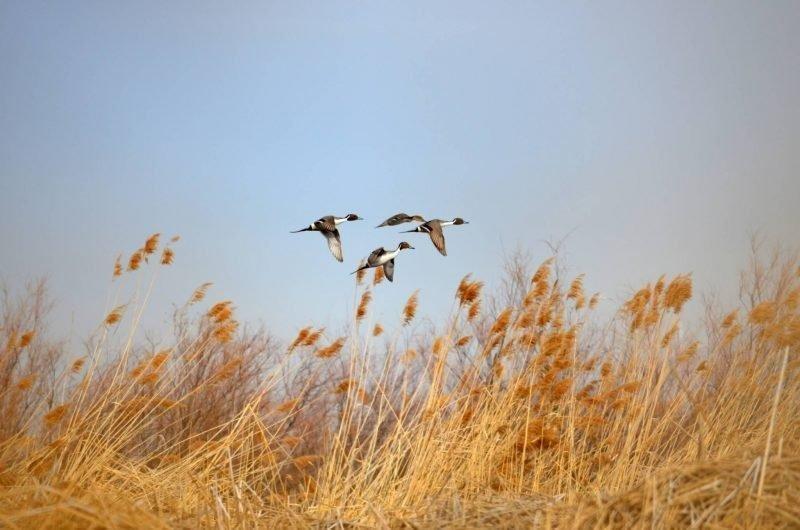Press Release
Duck and goose hunting zone changes—and a new daily limit for pintail ducks—are among changes awaiting Utah’s waterfowl hunters this fall.
All of the changes are available in the 2017 – 2018 Utah Waterfowl Guidebook. You can get the free guidebook at www.wildlife.utah.gov/guideboo
Blair Stringham, migratory game bird coordinator for the Division of Wildlife Resources, lists the major changes. He also provides information about the wetland conditions you can expect to find in Utah this fall.
Change 1 – One pintail a day
For the first time in several years, Utah hunters can take only one pintail duck a day. While most duck species are flourishing, the pintail population continues to fluctuate.
Stringham says biologists aren’t sure why pintails are struggling, but reduced funding through the Conservation Reserve Program might be one reason why. The CRP pays farmers to keep grasslands in their natural state and not farm them. Funding for the federal program has been reduced in recent years.
“Pintails tend to nest quite a ways from water,” he says, “in upland areas with plenty of native grasses. As CRP funding has decreased, more of these grassland areas are being farmed, leaving fewer areas for the pintails to nest.”
Urban development and long-term drought in central California, including a severe drought that gripped the area in 2015 and 2016, might also be factors. Most of the pintails in North America winter in central California. “Development and drought have led to fewer rice fields and wetlands for the birds,” he says.
Change 2 – Two duck hunting zones
Splitting Utah into two duck hunting zones—each with its own season dates—should make hunting better in southern Utah.
When past waterfowl seasons opened in early October, few ducks had made their way to southern Utah yet. “Creating two ducks hunting zones,” Stringham says, “each with its own season dates, allows the season in the South Zone to start one week later than it has in the past. Starting the season one week later means it can also end one week later, when there are still plenty of birds in the southern part of the state.”
The duck hunt in the North Zone runs from Oct. 7 to Jan. 20. In the South Zone, the hunt runs Oct. 14 – Jan. 27.
Having two duck zones also allows Utah to offer two Youth Waterfowl Hunting Days, one in each zone. The youth hunt in the North Zone happens Sept. 23. In the South Zone, the hunt happens Sept. 30.
Change 3 – Four goose hunting zones
Utah now has four goose hunting zones, the Eastern Box Elder, Northern, Southern and Wasatch. Boundary descriptions and season dates for each zone are available on pages 30 and 31 of the guidebook.
Change 4 – Rest area at Ogden Bay
A new waterfowl rest area should make hunting better at the Ogden Bay Waterfowl Management Area west of Hooper. The area, which is closed to hunting, is just west of the headquarters building. It’s about 250 acres in size.
Stringham says rest areas make hunting better by keeping birds on WMAs longer. “Rest areas are great for hunting,” he says. “After congregating on a rest area, the birds will fly from the rest area to other areas on the WMA. Rest areas keep birds on WMAs longer, providing hunters with chances to take birds that normally would have left because of hunting pressure.”
Change 5 – New way to get your HIP number
Those with smartphones and tablets have a new way to obtain their yearly Harvest Information Program (HIP) number. Just visit www.wildlife.utah.gov/uthip, and answer a few basic questions. After you do, your HIP number will appear on your screen. See page 10 of the guidebook for more information.
Wetland conditions
With two exceptions, wetland conditions in Utah should be similar to last year. Marsh conditions should be excellent at WMAs that are fed by rivers, including Farmington Bay and Ogden Bay. WMAs that are fed by springs, such as Public Shooting Grounds and Clear Lake, will be drier. Conditions at spring-fed WMAs should improve, though, as the season moves along.
The big news is Great Salt Lake. Currently, the water level is 4,194 feet above sea level. Last fall, the water level was below 4,189 feet, an all-time low.
The additional water flooded some of the fresh water portions of the lake, producing pondweed, salicornia, bulrush and other food for ducks and geese to eat. Stringham says every time the lake rises, even slightly, thousands of additional acres of wetlands become available to waterfowl.
The second exception is lakes and reservoirs that waterfowl use. The water level at many of the reservoirs and lakes in Utah is the highest it’s been in years. “More water means more habitat and resting areas for the birds,” he says.
Waterfowl Slam
If you’d like to add some fun, excitement and challenge to your hunt, while giving back to waterfowl and providing yourself with more places to hunt, consider earning some colorful leg bands in the state’s Waterfowl Slam. You can learn more about the slam at www.wildlife.utah.gov/utah-wat


